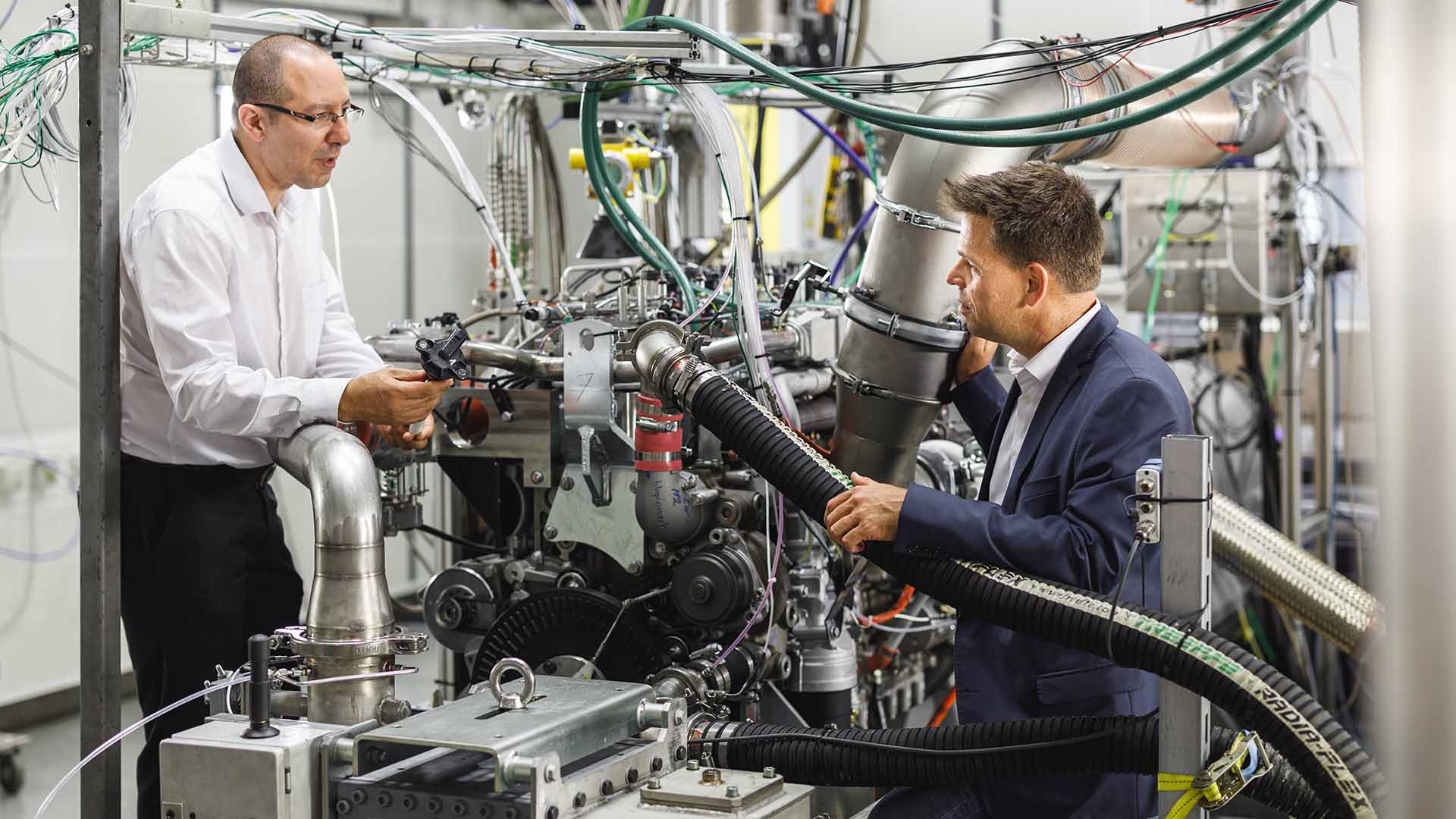A matter of chemistry
Hydrogen is a very special type of fuel: It is the most abundant chemical element in the universe, with a high energy density and is therefore a great hope on the road to reducing global carbon emissions. It is definitely worth a closer look. And that’s exactly what the engine development team at Liebherr-Components is doing in the Swiss town of Bulle. At Test Bench 54 for diesel and H₂ engines, the team led by Dr Bouzid Seba, head of combustion engine pre-development, has carried out its latest project. It is a hydrogen ICE with direct H₂ injection, installed onto the test platform and connected to a tangle of cables, strings and hoses, which continuously send data on operating conditions, emissions and performance to the control station. Hydrogen from renewable energy sources has long been seen as a beacon of hope for a climate-friendly, CO₂-neutral energy supply. “Again and again, hydrogen seemed to be on the verge of a breakthrough as an infinite source of energy, only to disappear again into oblivion," explains Dr Seba. However, the tables have turned in the meantime, which has led to a reassessment in the politics and especially in the construction machinery market. “Wherever batteries or fuel cells reach their limits, hydrogen ICEs can be the solution. This is primarily the case in applications where the engine is exposed to strong vibrations or where there is a lot of dust and dirt. This mainly concerns mobile construction machinery like crawler excavators, but also heavy-duty vehicles.”
Wherever batteries or fuel cells reach their limits, hydrogen ICEs can be the solution.
The engine engineering team in Bulle is currently examining different injection and combustion technologies for hydrogen ICEs. Liebherr’s decades of experience with diesel and gas engines boost the development: The mechanics, crankshafts, bearings and turbochargers do not have to be developed from scratch, a fact that greatly shortens the time prior to intensive field testing.

This becomes particularly obvious in the latest cooperation between Liebherr Machines Bulle SA and Liebherr-France SAS in Colmar for the development of the R 9XX H₂, a 50-tonne crawler excavator equipped with the hydrogen ICE. Henrik Weitze, project manager at Liebherr-France SAS, has worked closely with Dr Seba’s team for many years. Weitze sees the newly designed hydrogen ICE for the R 9XX H₂ as predestined for use on construction sites at extremely high temperatures or under shocks and in particularly dust-intensive environments typical of earthmoving or quarries. “Like all our crawler excavators, the R 9XX H₂ with its alternative drive meets the highest quality standards under extreme conditions," explains Weitze. Keeping this in mind, the engineering team in Colmar designed the machine taking the latest, future-oriented crawler excavator Generation 8 as the basis. “The overall performance is in no way inferior to the diesel version, be it power output, engine dynamics or response during dynamic load changes," explains Henrik Weitze. The only difference is the refuelling process, special infrared communication between the excavator and the filling station makes it both fast and safe.
The hydrogen ICE developed for the R 9XX H₂ in Bulle is based on port fuel injection (PFI). “The accuracy and quantity of hydrogen injection is an essential requirement for heavy-duty ICEs," explains Dr Seba. “To align the performance of a H₂-engine to that of a diesel engine, the system has to be able to guarantee the different requirements in terms of flow and injection accuracy. Hydrogen gas has a low density, which requires large valve cross-sections in the injector. We were able to combine different components to control pressure and flow rates.”
Like all our crawler excavators, the R 9XX H₂ with its alternative drive meets the highest quality standards under extreme conditions.
The hydrogen ICE developed for the R 9XX H₂ in Bulle is based on port fuel injection (PFI). “The accuracy and quantity of hydrogen injection is an essential requirement for heavy-duty ICEs," explains Dr Seba. “To align the performance of a H₂-engine to that of a diesel engine, the system has to be able to guarantee the different requirements in terms of flow and injection accuracy. Hydrogen gas has a low density, which requires large valve cross-sections in the injector. We were able to combine different components to control pressure and flow rates.”

Following PFI, direct H₂ injection developed by Liebherr will be tested in terms of performance in particularly dynamic heavy-duty applications. “During our tests, we aim to gather large quantities of input data from the operating conditions of the H₂ engine," explains Dr Seba. On four monitors, the developers can follow the engine performance in real time and make adjustments and optimisations simultaneously. Thanks to digitalisation, the speed of development is significantly higher today than even a few years ago. “Before the engine even gets to the test bench, we can use simulations to evaluate it under different operating conditions and incorporate their effects into the engine architecture right away.”
Henrik Weitze thinks that Liebherr is on the right track towards making a relevant contribution to the climate goals. The “Green Deal”, with which the EU wishes to become climate-neutral by 2050, is also setting the course for the development team. As early as 2030, CO₂ emissions are to be reduced by at least 55 per cent as compared to 1990. Weitze is convinced: “That’s a tight deadline, but we will make it. Until then, it is important to never lose sight of the goal, even when things get tough along the way.” The engineering team in Bulle intends to start with the serial production of the H₂ engine by 2025.





